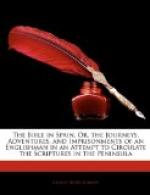The Carcel de la Corte, where I now was, though the principal prison of Madrid, is one which certainly in no respect does credit to the capital of Spain. Whether it was originally intended for the purpose to which it is at present applied, I have no opportunity of knowing. The chances, however, are, that it was not; indeed it was not till of late years that the practice of building edifices expressly intended and suited for the incarceration of culprits came at all into vogue. Castles, convents, and deserted palaces, have in all countries, at different times, been converted into prisons, which practice still holds good upon the greater part of the continent, and more particularly in Spain and Italy, which accounts, to a certain extent, for the insecurity of the prisons, and the misery, want of cleanliness, and unhealthiness which in general pervade them.
I shall not attempt to enter into a particular description of the prison of Madrid, indeed it would be quite impossible to describe so irregular and rambling an edifice. Its principal features consisted of two courts, the one behind the other, intended for the great body of the prisoners to take air and recreation in. Three large vaulted dungeons or calabozos occupied three sides of this court, immediately below the corridors of which I have already spoken. These dungeons were roomy enough to contain respectively from one hundred to one hundred and fifty prisoners, who were at night secured therein with lock and bar, but during the day were permitted to roam about the courts as they thought fit. The second court was considerably larger than the first, though it contained but two dungeons, horribly filthy and disgusting places; this second court being used for the reception of the lower grades of thieves. Of the two dungeons one was, if possible, yet more horrible than the other; it was called the gallineria, or chicken coop, and within it every night were pent up the young fry of the prison, wretched boys from seven to fifteen years of age, the greater part almost in a state of nudity. The common bed of all the inmates of these dungeons was the ground, between which and their bodies nothing intervened, save occasionally a manta or horse-cloth, or perhaps a small mattress; this latter luxury was, however, of exceedingly rare occurrence.
Besides the calabozos connected with the courts, were other dungeons in various parts of the prison; some of them quite dark, intended for the reception of those whom it might be deemed expedient to treat with peculiar severity. There was likewise a ward set apart for females. Connected with the principal corridor were many small apartments, where resided prisoners confined for debt or for political offences. And, lastly, there was a small capilla or chapel, in which prisoners cast for death passed the last three days of their existence in company of their ghostly advisers.




